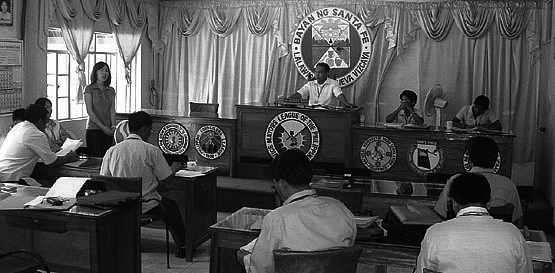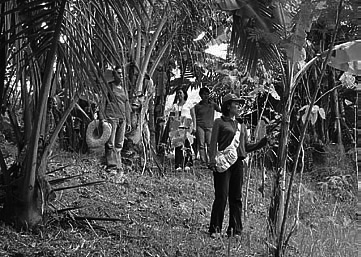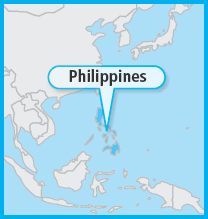Japan's Official Development Assistance White Paper 2009
Column 20 Forest Management by the Locals
— Participatory Forest Management in the Philippines —
The Province of Nueva Vizcaya is about a seven-hour bus ride northward from the Philippine capital Manila. It is surrounded by the Sierra Madre mountain range and is located in a magnificent natural setting, and it contains two large rivers: the Magat and the Cagayan. The province is a critical watershed area supporting the largest grain-growing region in the Philippines, but serious forest degradation is progressing there due to excessive logging in the past and subsequent widespread grazing and slash-and-burn agriculture. As a result, farmers are forced to carry out agriculture relying on fertilizers and agricultural chemicals and the yield amounts of staple food, rice and vegetables, are declining, which has a big impact on consumers. Although the departments and agencies in charge in the government of the Philippines take this problem seriously, they have been unable to take effective measures due to a lack of budget and personnel.
The GLM Institute (GLMi), a Japanese NGO, set out to address this problem. In 2008, it began a project*1 to support forest management by the local people, cooperating with local NGOs*2 and receiving assistance. from the Japanese government*3 etc. According to project leader Ms. Makiko Soma, it was initially difficult to get government agencies, schools, and local residents to cooperate. Over-logging, for example, is a cause of forest degradation, but the trees that are cut down are sold overseas and are a source of income to communities, leading people to resist any changes to the way they have lived up until now. Ms. Soma looks back on the initial activities, saying, "The administrative authorities know the importance of forest management, but they are not able to do much about it because of a lack of funds and manpower. The national government, municipalities, boards of education, and other relevant parties have limited resources. We therefore thought it would be necessary to provide cooperation so that they would help each other make up for their shortages."
Ms. Soma thus worked hard to show the significance and importance of the project to governments, schools, and the local people. The people gradually came to understand its importance, and forest management by the local residents got underway. Ms. Soma skillfully used the method of having the relevant parties help each other and make use of their individual strong points. GLMi played the role of a go-between, and the forest management activities began.
Forest management requires the regeneration of forests, including soil. The government and local residents first created 32-hectare model farms in four towns and villages. The farms utilized a traditional method to prevent the washing away of soil by striking dead branches and so forth at equal spaces, and additionally, close to 10,000 trees were planted. While elementary school students are given education on the environment, they have planted a total of 3,000 trees. Through such activities, people have been reminded of the importance of protecting the environment, and they have become proactively involved in the activities.
GLMi places a focus on self-help efforts and the development of human resources and is gradually handing over training and the role of go-between with agencies to the local residents. A local village head happily says, "GLMi's efforts have not only brought about forest management by local residents, but have also given us an opportunity to reexamine our relationship with nature and our way of living." Now that the natural environment is being regenerated and people's attitudes are changing, Ms. Soma is working on activities with the people to protect nature with a view toward a day in the future when the local residents of Nueva Vizcaya are able to manage the forests on their own.
*1 Promotion of Participatory Forest Management in the Critical Watershed of Nueva Vizcaya Province
*2 Philippine Rural Reconstruction Movement (PRRM)
*3 Grant Assistance for Japanese NGO Projects

Requesting a local government for cooperation with forest management. (Ms. Soma is the second on the left.) (Photo: GLMi)

Ms. Soma inspecting a tree planting site at an elementary school. (Ms. Soma is in front on the right.) (Photo: GLMi)

